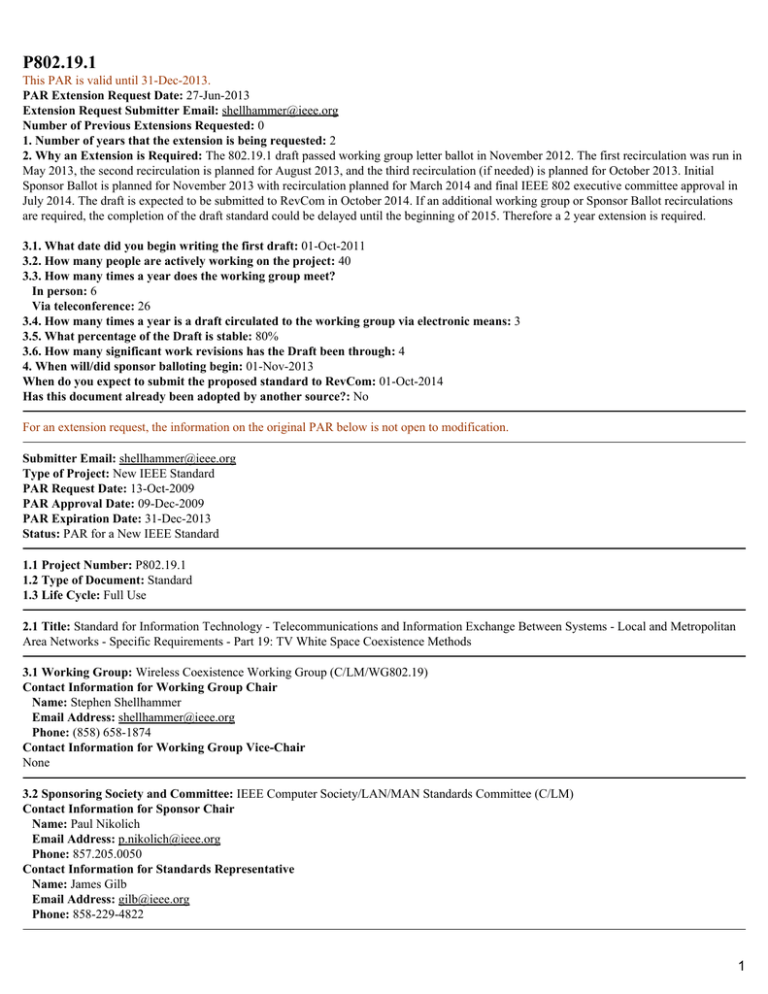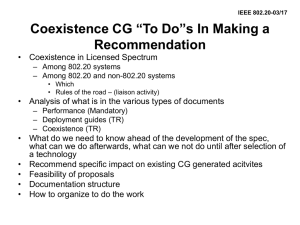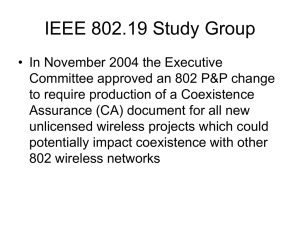P802.19.1 - IEEE 802
advertisement

P802.19.1 This PAR is valid until 31-Dec-2013. PAR Extension Request Date: 27-Jun-2013 Extension Request Submitter Email: shellhammer@ieee.org Number of Previous Extensions Requested: 0 1. Number of years that the extension is being requested: 2 2. Why an Extension is Required: The 802.19.1 draft passed working group letter ballot in November 2012. The first recirculation was run in May 2013, the second recirculation is planned for August 2013, and the third recirculation (if needed) is planned for October 2013. Initial Sponsor Ballot is planned for November 2013 with recirculation planned for March 2014 and final IEEE 802 executive committee approval in July 2014. The draft is expected to be submitted to RevCom in October 2014. If an additional working group or Sponsor Ballot recirculations are required, the completion of the draft standard could be delayed until the beginning of 2015. Therefore a 2 year extension is required. 3.1. What date did you begin writing the first draft: 01-Oct-2011 3.2. How many people are actively working on the project: 40 3.3. How many times a year does the working group meet? In person: 6 Via teleconference: 26 3.4. How many times a year is a draft circulated to the working group via electronic means: 3 3.5. What percentage of the Draft is stable: 80% 3.6. How many significant work revisions has the Draft been through: 4 4. When will/did sponsor balloting begin: 01-Nov-2013 When do you expect to submit the proposed standard to RevCom: 01-Oct-2014 Has this document already been adopted by another source?: No For an extension request, the information on the original PAR below is not open to modification. Submitter Email: shellhammer@ieee.org Type of Project: New IEEE Standard PAR Request Date: 13-Oct-2009 PAR Approval Date: 09-Dec-2009 PAR Expiration Date: 31-Dec-2013 Status: PAR for a New IEEE Standard 1.1 Project Number: P802.19.1 1.2 Type of Document: Standard 1.3 Life Cycle: Full Use 2.1 Title: Standard for Information Technology - Telecommunications and Information Exchange Between Systems - Local and Metropolitan Area Networks - Specific Requirements - Part 19: TV White Space Coexistence Methods 3.1 Working Group: Wireless Coexistence Working Group (C/LM/WG802.19) Contact Information for Working Group Chair Name: Stephen Shellhammer Email Address: shellhammer@ieee.org Phone: (858) 658-1874 Contact Information for Working Group Vice-Chair None 3.2 Sponsoring Society and Committee: IEEE Computer Society/LAN/MAN Standards Committee (C/LM) Contact Information for Sponsor Chair Name: Paul Nikolich Email Address: p.nikolich@ieee.org Phone: 857.205.0050 Contact Information for Standards Representative Name: James Gilb Email Address: gilb@ieee.org Phone: 858-229-4822 1 4.1 Type of Ballot: Individual 4.2 Expected Date of submission of draft to the IEEE-SA for Initial Sponsor Ballot: 12/2012 4.3 Projected Completion Date for Submittal to RevCom: 09/2013 5.1 Approximate number of people expected to be actively involved in the development of this project: 30 5.2 Scope: The standard specifies radio technology independent methods for coexistence among dissimilar or independently operated TV Band Device (TVBD) networks and dissimilar TV Band Devices. 5.3 Is the completion of this standard dependent upon the completion of another standard: No 5.4 Purpose: The purpose of the standard is to enable the family of IEEE 802 Wireless Standards to most effectively use TV White Space by providing standard coexistence methods among dissimilar or independently operated TVBD networks and dissimilar TVBDs. This standard addresses coexistence for IEEE 802 networks and devices and will also be useful for non IEEE 802 networks and TVBDs. 5.5 Need for the Project: Existing IEEE 802 standards groups are developing standards and amendments, to comply with the regulatory rules for use of TV white space. Other non-IEEE 802 wireless standards for use of the TV White Space are also in development. In order for these various dissimilar TVBD networks and devices to effectively coexist in the TVWS spectrum, fair and efficient spectrum sharing is needed. Fair and efficient spectrum sharing among dissimilar TVBD networks and devices may require the coexistence methods provided in this standard. In order to enhance utilization of the TV White Space bands standardized coexistence methods are needed. Methods such as those discussed in the explanatory notes may be considered. 5.6 Stakeholders for the Standard: Designers of TVWS MAC/PHY standards and implementations. Intellectual Property 6.1.a. Is the Sponsor aware of any copyright permissions needed for this project?: No 6.1.b. Is the Sponsor aware of possible registration activity related to this project?: No 7.1 Are there other standards or projects with a similar scope?: Yes If Yes please explain: IEEE P1900.4a is a standards project which addresses dynamic spectrum access. IEEE P802.22 is a MAC/PHY standards project for operation in the TVWS which includes coexistence mechanisms. Ecma International TC48-TG1 is a MAC/PHY standards project for operation in the TVWS which includes coexistence mechanisms and answer the following Sponsor Organization: IEEE ECMA International Project/Standard Number: P1900.4a / P802.22 / TC48-TG1 Project/Standard Date: 30-Dec-2012 Project/Standard Title: Standard for Architectural Building Blocks Enabling Network-Device Distributed Decision Making for Optimized Radio Resource Usage in Heterogeneous Wireless Access Networks - Amendment: Architecture and Interfaces for Dynamic Spectrum Access Networks in White Space Frequency Bands / Draft Standard for Wireless Regional Area Networks Part 22: Cognitive Wireless RAN Medium Access Control (MAC) and Physical Layer (PHY) specifications: Policies and procedures for operation in the TV Bands / Wireless Communications using Television White Spaces (TVWS) 7.2 Joint Development Is it the intent to develop this document jointly with another organization?: No 8.1 Additional Explanatory Notes (Item Number and Explanation): Section 5.2 (Scope) Coexistence Method - Consists of the following components, A means of communication between nodes A protocol for exchanging information A set of coexistence parameters providing information about the interference environment and the set of MAC/PHY capabilities Algorithms for adapting MAC/PHY parameters to enhancing coexistence between networks The communication between the nodes is based on other standards, either wired or wireless, and is not part of this standard. Section 5.2 (Scope) The term "radio technology independent" means that the methods work with a variety of MAC/PHY standards, which support some or all of a set of typically implemented MAC/PHY capabilities. 2 Section 5.2 (Scope) The term dissimilar used in this document refers to the networks and devices, which use different radio technologies adapted for TV White Space Frequency Bands. Section 5.2 (Scope) The term independently operated used in this document refers to networks which may or may not use the same radio technology but are operated by independent entities which do not necessarily have a business relationship for coordinating their use of TV White Space Frequency Bands; furthermore, such similar radio access technologies may not have an otherwise available means of coexistence. For example, this differentiates independently operated from a situation in which a single administrative authority manages the coexistence between dissimilar technologies deployed in a composite network. Section 5.2 (Scope): The term "TVBD" is the FCC term for TV Band Device which refers to any device which complies with FCC rules to allow unlicensed radio transmitters to operate in the broadcast television spectrum at locations where that spectrum is not being used by licensed services. A TV band device (TVBD) is a low power transmitter that operates on an unoccupied TV channel in the range of channels 2-51, excluding channels 3-4 and 37. Sec. 5.5 (Need): The radio technology independent coexistence methods that are standardized may address the following and related areas: Discovery is the process of determining that there are two or more dissimilar and independently operated wireless networks or devices attempting to use the same White Space frequency range in the same location. This can occur in two ways. The two networks or devices may attempt to enter at the same time or one may be present and a second seek to enter. In the second case, a network operating in White Space, must periodically check for new entrants and a new entrant must check before entering. A Connection for coexistence may be useful for two dissimilar and independently operated wireless networks or devices to exchange information in order to share spectrum. A Logical Method for Promoting Coexistence is a method that involves the exchange of information between different dissimilar or independently operated networks or devices and may also involve algorithms seeking to maximize the quality of service for all participants. This standard project addresses USA FCC TV White Space Rules and may address the TV White Space rules of other regulatory domains. During the project lifetime, the draft standard may be modified to address any new or changing regulatory White Space Rules. 3

